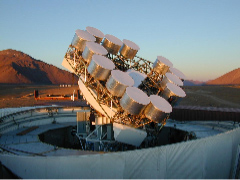
The CBI (see Udomprasert et al. paper)

The CBI (see Udomprasert et al. paper)
J CARLSTROM .ps
The Sunyaev-Zel'dovich effect (SZE) provides a powerful tool for cosmological studies. Through recent advances in instrumentation and observational techniques it is now possible to obtain high quality measurements of the effect toward galaxy clusters. The analysis of the SZE toward a few tens of clusters has already led to interesting constraints on the Hubble constant and the mass density of the universe. In the near future, instruments exploiting the redshift independence of the SZE will be used to conduct deep surveys for galaxy clusters providing detailed information on the growth of large scale structure, tests of cosmological models and tight constraints on the cosmological parameters that describe our universe. In this review we provide an overview of the SZE and its use for cosmological studies. We summarize the current state of observations and the constraints on cosmological parameters already obtained and we discuss the power of using the SZE for future deep cluster surveys.
JOSEPH J. MOHR et al. .ps .pdf
Galaxy clusters in the nearby universe exhibit evidence for regularity on the scale of their virial regions, which is comparable to the regularity in elliptical galaxies. We review observations of the X-ray isophotal Size-Temperature (ST) relation in the nearby universe, and then we examine an ensemble of clusters at intermediate redshift. We show-- using archival ROSAT HRI data-- that the 11 CNOC clusters with measured ICM temperatures exhibit a ST relation with slope and scatter consistent with the local relation. Using the canonical structure formation model, we argue that the ST relation normalization is not expected to evolve with redshift, making it a potentially interesting distance indicator. We show that the observed intermediate redshift ST relation normalization excludes the \Omega_M=1 model, but is consistent with the \Omega_M=0.3 and \Omega_\Lambda=0.7 model.
GILBERT P. HOLDER, JOHN E. CARLSTROM AND AUGUST E. EVRARD .ps .pdf
Weak lensing and the Sunyaev-Zel'dovich effect (SZE) are each measures of the projected mass distribution of galaxy clusters. Weak lensing is probing the projected total mass, while the SZE is probing the projected (temperature-weighted) gas distribution. Direct comparisons of the two distributions should allow determinations of the gas mass fraction and the gas temperature. With a local calibration of the true gas fraction, it should be possible to estimate angular diameter distances to clusters as well. Interferometric measurements must be handled carefully, however, with the proper analysis done in the Fourier domain, rather than on the reconstructed images. We present a non-parametric method for comparing the SZE and mass distributions that properly accounts for the finite fields of view of both the interferometer and the weak lensing shear measurements. At the sensitivity limits of current instruments, we estimate that the gas fraction can be determined to an accuracy better than $20\%$ if the gas temperature is known from other methods, while the temperature can be estimated to a comparable precision if the redshift distribution of lensed sources is approximately known.
We present preliminary results from a maximum likelihood joint analysis of 30 GHz interferometric Sunyaev-Zel'dovich Effect (SZE) and X-ray observations for a sample of 14 high redshift (0.14 leq z leq 0.78) clusters of galaxies. From the joint SZE and X-ray analysis we determine the distances to the 14 galaxy clusters. These distances imply a Hubble parameter of 63^{+4}_{-4}^{+19}_{-19} km s^{-1} Mpc^{-1} for a Omega_M=0.3 and Omega_Lambda=0.7 cosmology, where the uncertanties are statistical followed by systematic at 68 % confidence. The implied Hubble constant is 59 ksM for an open Omega_M=0.3 universe and 56 ksM for a flat Omega_M=1 cosmology. We briefly discuss possible sources of systematic uncertainty and their controllable nature.
F.J. CASTANDER et al. .ps .pdf
We combine observations in the optical, radio and X-rays of the cluster of galaxies CL0016 to constrain its gravitational potential. These observations include deep Keck imaging in the optical; BIMA and OVRO interferometric observations at cm wavelengths and ROSAT PSPC and HRI X-ray imaging. Each observation provides different information about the cluster: the distortions of background galaxies depend on the cluster projected potential; the Sunyaev-Zeldovich decrement, on the integrated pressure and the X-ray emission, on the square of the projected gas density (if isothermal). We use a maximum likelihood analysis to combine these data to derive the cluster potential. We discuss different approaches to construct the likelihood functions, the different assumptions required and the current status of the project.}
P.S. UDOMPRASERT, B.S. MASON, AND A.C.S. READHEAD .ps .pdf
We are engaged in a program with the Cosmic Background Imager (CBI), a 13-element interferometer recently installed at 5000 m in the Chilean Andes, to measure $H_0$ with 10 % accuracy through observations of the Sunyaev-Zel'dovich effect in a sample of nearby clusters. We discuss the capabilities of this new instrument and present our cluster sample and selection criteria, along with results from detailed simulations. We also present preliminary observations of Abell 478.